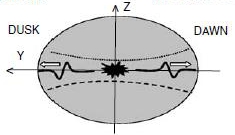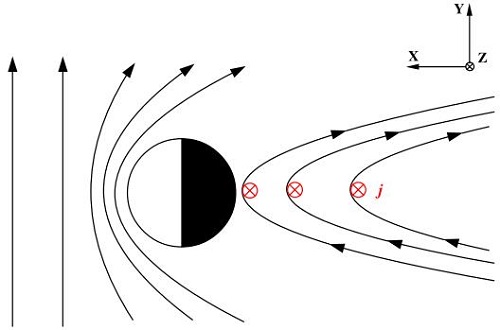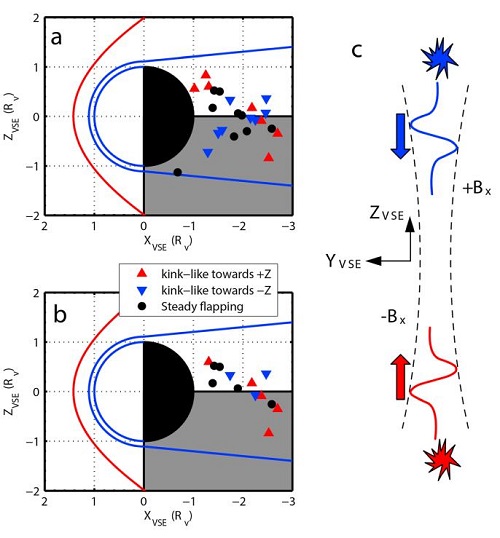The interaction of the solar wind with Earth's intrinsic dipole field stretches the night-side magnetic field into a magnetotail. In the magnetotail, a transition layer separating the antiparallel lobe field lines is referred as magnetotail current sheet and this is where the magnetic field strength reaches a minimum, and the current density and plasma density are relatively higher than that in the lobe regions. Considerable magnetospheric energy stored in magnetotail and can be released in the form of fast plasma flow, plasma heating, and various waves, which are presumed to power geomagnetic storm/substorms and induce geomagnetic field disturbances and aurora. As a form of released energy, the flapping motion of current sheet has recently drawn increasing attention.
Earlier studies noted that Earth's magnetotail current sheet often flaps back and forth, which leads to multiple current sheet crossings being recorded by spacecraft. In the past decade, using four-point observations from the Cluster mission, it was found that these local flapping motions (Figure 1), which are triggered by some impulsive sources around midnight region, are able to propagate as kink-like waves toward both flanks (the boundaries between magnetotail current sheet and magnetosheath). These waves can travel at speeds of a few tens of kilometers/seconds with wavelengths of several Earth radii. Currently, the mechanisms driving the kink-like waves are still unclear.

Figure 1. The travelling of kink-like flapping motion of Earth's magnetotail current sheet (adapted from Sergeev et al., 2004). The undisturbed current sheet is in XY plane.
The interaction of the solar wind with Venus also induces a magnetotail although Venus lacks a significant magnetic dipole moment. As shown in Figure 2, due to the differential motion between the interplanetary magnetic field (IMF) and the Venusian ionospheric plasma, electric currents are induced in the ionosphere, which cause the IMF to pileup and drape over the planet. As the draped magnetic field slips into the wake region, the induced magneotail is formed. Accordingly, a tail current sheet is induced and separates the two lobe regions with antiparallel field lines. The flapping motion of Venusian magnetotail has been noticed in some observational studies, but it is yet unknown whether the induced current sheet exhibits a flapping motion similar to that found in Earth magnetotail. The comparative study of flapping motions could provide information not only to identify the mechanism behind flapping, but also to understand the dynamic processes operating in the Venusian magnetotail.

Figure2. The formation of the Venus induced magnetotail.
The major challenge of studying Venusian magnetotail flapping motion is how to use the single-point measurement to resolve the flapping properties, because the current sheet flapping velocity cannot be derived from the single-point measurement. Recently, Rong Zhaojin developed a new technique based on single-point magnetic field measurements [Rong et al., 2015a], which is capable of qualitatively distinguishing the different flapping types, as well as the propagation direction if the flapping motion can travel as kink-like waves.
Rong and colleagues subsequently applied this technique to study the Venusian magnetotail flapping, which was detected by the Venus Express mission [Rong et al., 2015b]. They found that the flapping of Venus' magnetotail consists of two forms: 1) steady flapping where the waves cannot propagate, and 2) kink-like flapping, where the flapping motion can propagate as travelling waves. Rong et al went on to show that the propagation of kink-like flapping is distinct from that seen in Earth's magnetotail. As shown in Figure 3, the propagation behavior suggests that the sources triggering the kink-like waves are located near the Venusian magnetotail flanks, not in the central region of current sheet as is the case for Earth's magnetotail.
They speculated that, the kink-like flapping of a planetary magnetotail would be Earth-like if the planet has significant dipole moment, but would Venus-like if it has no significant dipole moment. This hypothesis can further tested in future studies.

Figure 3. The flapping properties of Venusian tail current sheet. The undisturbed current sheet is in YZplane.
This work has been published in the following papers:
1. Rong, Z. J., et al., (2015), Technique for diagnosing the flapping motion of magnetotail current sheets based on single-point magnetic field analysis, J. Geophys. Res. Space Physics, 120, 3462–3474, doi: 10.1002/2014JA020973.
2. Rong, Z. J., et al., (2015), The flapping motion of the Venusian magnetotail: Venus Express observations, J. Geophys. Res. Space Physics, 120, doi: 10.1002/2015JA021317.
Contact:
RONG Zhaojin
Division of Geomagnetism and Space Physics, IGGCAS
E-mail: rongzhaojin@mail.iggcas.ac.cn




